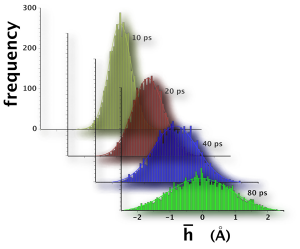A Walk along an Interface Yields Its Mobility
October 27, 2006
GOLDEN, Colo. — In this week's issue of Science (volume 314, page 632), researchers at the Colorado School of Mines and Northeastern University report a novel computational methodology aimed at quantifying the kinetics of interfaces in diverse material systems. The paper, titled "Interface Mobility from Interface Random Walk," addresses computational issues in extracting interface kinetic parameters under experimentally relevant conditions. It is currently available online in Science Vol. 314, No. 5799.
Interfaces are an important class of defects whose distribution affects the properties of the otherwise pristine material, both in nature and in technology. This is especially the case in polycrystals, thin films, multiphase materials, and composites, where the mechanical, chemical, and transport properties are sensitive to the underlying interfacial microstructure. "In fact, tailoring this microstructure is an emerging paradigm for engineering high performance, multifunctional materials," said Zachary Trautt, a graduate student and the first author in the study.

Figure 1: Animation of a slice through a computational cell consisting of two grain boundaries which separate two perfect crystals of different orientations. The average position of the grain boundaries is calculated from their fluctuating profile.
The interfacial microstructure is subject to several driving forces during material synthesis and function. More often than not, these driving forces are large enough to cause the interfaces to move and the microstructure (or its precursor) to evolve (Figure 1). Naturally, controlling the final microstructure requires accurate models (Figure 2) that relate the interface motion to the driving forces in effect.
A quantitative measure of interface kinetics is the interface mobility, the ratio of the interface velocity to the driving force. Past studies on individual homophase crystalline interfaces (or grain boundaries) in several high-purity metals show an interesting trend: the experimental mobilities are orders of magnitude smaller than those extracted via computations. The discrepancy is often attributed to the presence of impurities, fueling speculation that even minute quantities of impurities significantly retard interface motion.
"An often overlooked fact is that computations are limited to tens of nanoseconds," said Moneesh Upmanyu, co-author and the lead researcher in the study. "As a result, they are performed at driving forces orders of magnitude greater than those commonly observed in experiments," he explained. This further weakens the comparison, and there is a need to extend the computational studies to more realistic driving forces and include the effect of impurities.

Figure 2: The time evolution in picoseconds (ps) of the distribution of the average grain boundary position . The distributions are normal, as predicted by the theory. (Image courtesy of Science.)
"Our computational methodology offers a way to address both these challenges, efficiently and with setups that are relatively simple," said Trautt. The basis for the methodology is the pioneering theoretical work by Einstein, Smulochowski and Langevin on Brownian motion in the early 1900s. "Just as their study related the dance of macroscopic particles to their diffusivity, the microscopic thermal fluctuations result in interface forces that conspire towards a one-dimensional dance of the average interface position, which in turn yields its mobility in the zero driving force limit," said Alain Karma, also a co-author in the study. "The technique is remarkably efficient," noted Upmanyu. "The computations on pure aluminum yielded mobilities within a nanosecond, a significant savings in computational resources."
Comparisons with previous experiments and computations reveal that the retarding effect of impurities is much more severe than previously thought. The authors are now working on extending the theory and the computations to directly quantify the impurity drag effect.
Authors of the paper include Zachary Trautt, graduate student in Group for Simulation and Theory of Atomic-scale Material Phenomena (stAMP), Engineering Division, Colorado School of Mines; Moneesh Upmanyu, group leader of stAMP and Assistant Professor in the Engineering Division and Materials Science Program at Colorado School of Mines; and Alain Karma, Distinguished Professor in the Department of Physics and Center for Interdisciplinary Research on Complex Systems, Northeastern University.
The study was funded by Department of Energy (BES, Dale Koelling), Department of Defense (ONR, Julie Christodoulou), and Alcoa Technical Center (Hasso Weiland), and used the computing resources of the Naval Oceanographic Office Major Shared Resource Center and NERSC.
About NERSC and Berkeley Lab
The National Energy Research Scientific Computing Center (NERSC) is a U.S. Department of Energy Office of Science User Facility that serves as the primary high performance computing center for scientific research sponsored by the Office of Science. Located at Lawrence Berkeley National Laboratory, NERSC serves almost 10,000 scientists at national laboratories and universities researching a wide range of problems in climate, fusion energy, materials science, physics, chemistry, computational biology, and other disciplines. Berkeley Lab is a DOE national laboratory located in Berkeley, California. It conducts unclassified scientific research and is managed by the University of California for the U.S. Department of Energy. »Learn more about computing sciences at Berkeley Lab.







